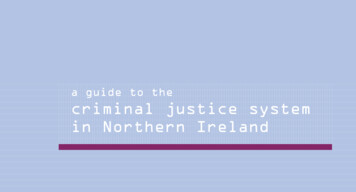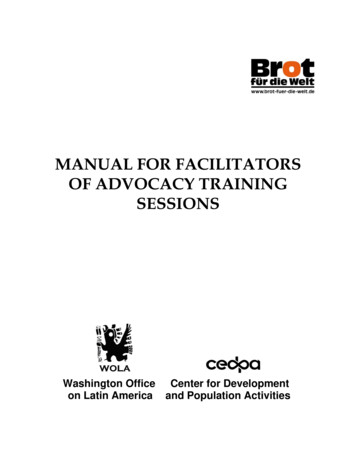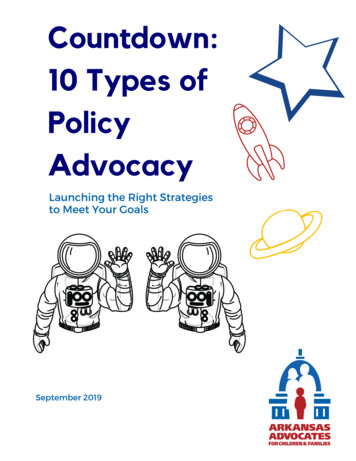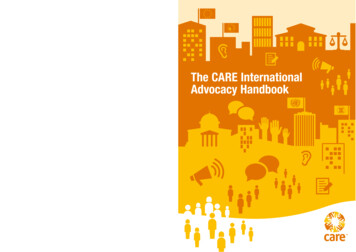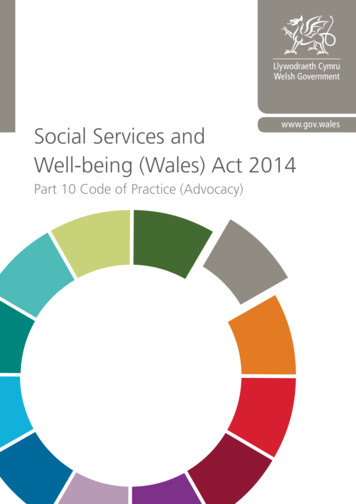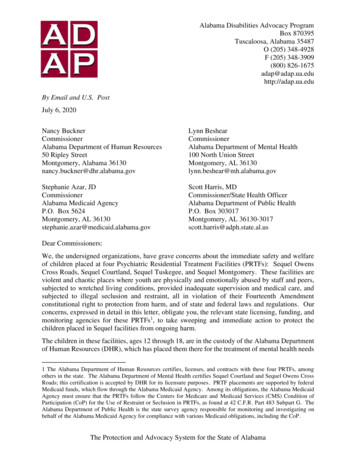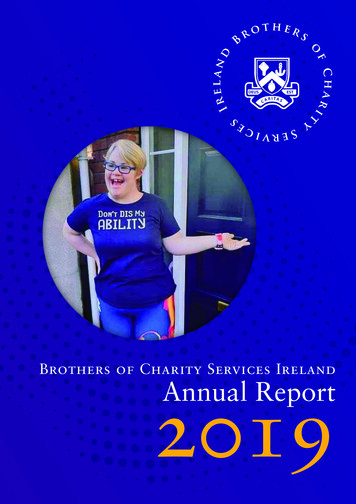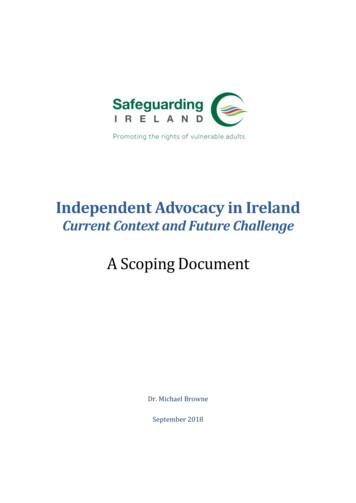
Transcription
Independent Advocacy in IrelandCurrent Context and Future ChallengeA Scoping DocumentDr. Michael BrowneSeptember 2018
ContentsPageIntroduction2Why advocacy is important4Safeguarding vulnerable adultsAn ageing population56Population categories who may need advocacyA diverse vulnerable adult populationDefining and Understanding AdvocacyDifferent types of advocacy7789Patient advocacySystemic advocacyInstructed and Non-instructed advocacy91213Independent advocacy14Advocacy and health and social care professionalsRole of families/relatives1415The role of the independent advocate16Access to independent advocacy17Advocacy and human rightsWhat are human rightsHuman rights charters and conventionsHuman rights principlesAutonomy and the right to self-determinationDeprivation of liberty181818192022Advocacy and supported decision-making22Advocacy and legislative provision in Ireland24Advocacy Practice: Quality standards, skills and competenciesAdvocacy skills and competencies2629Advocacy and vulnerable adults: the practice in other jurisdictions29Developing a National Framework for Advocacy in IrelandChallenges to independent advocacy in the Irish contextA changed discourseNational Advocacy CouncilOverview and Conclusion3235363638AppendicesAppendix One: Public Perspectives on Abuse of Vulnerable Adults in IrelandAppendix Two: Current and Projected Over 60 Population in IrelandAppendix Three: Advocacy Competencies4041421 Page
IntroductionThe purpose of this Scoping Document is to inform the deliberations of a NationalRoundtable on Advocacy Provision in Ireland to be held on 17th October 2018 which is beingorganised by Safeguarding Ireland. It sets out the key factors underpinning advocacy anddescribes the current position relating to advocacy services in Ireland as these apply toadults who may be vulnerable. In particular, the document aims to provide a context fordeveloping an informed and common understanding around the language and conceptsrelating to advocacy. This is considered necessary in order to identify clear pathways for thedevelopment of independent advocacy services in Ireland.While the term ‘advocacy’ is relatively new, historically, there have consistently been peoplewilling to speak up for others and in order to ensure that their interests are represented.During the 20th century, out of a diverse range of movements concerned with human, civil,social and political rights for the individual citizen, there emerged concepts, practices andservices which can be broadly described as advocacy.Six points need to be highlighted at the outset:1) It is critically important to have a clear understanding of what advocacy is, where itfits in the overall social supports infrastructure and who is likely to need and benefitfrom advocacy.2) It is important that the underpinning principles of advocacy are identified andexplored.3) The social and legislative context within which advocacy is, or should be, providedneeds to be understood.4) Advocacy practice/services have a protective or safeguarding role as well as anempowering dimension.5) While many health and social care professionals have an advocacy role, there is animportant distinction between the advocacy role of such professionals and the roleof independent advocates.16) The issue of legal recognition in Ireland for independent advocacy needs to beaddressed with some urgency.It should also be noted that the current advocacy landscape in Ireland is quite varied interms of responsibilities, funding and independence. For example, the National AdvocacyService for People with Disabilities (NAS) is funded by the Department of Employment and1Independent advocacy refers, essentially, to advocacy support provided by an organisation that is structurallyand financially autonomous and independent from the services that deliver health and social care, as well asfrom the family of the person to whom the advocacy service is being provided.2 Page
Social Protection through the Citizens Information Board while statutory funding for otherindependent advocacy services at national and local levels is provided by the HSE. Theabsence to date of a legislative remit for independent advocacy2 other than under theMental Health Act 2001 results in an advocacy environment that is somewhat unclear andwithin which there are multiple understandings of advocacy.As will be outlined in the document, the legislative landscape as it applies to advocacy hasbegun to change fundamentally in recent years.Structure of Scoping DocumentThe Document deals with a number of aspects of advocacy provision under the followingthemes: Why advocacy is importantDefining and understanding advocacyIndependent advocacyAdvocacy and a human rights approachAdvocacy and legislation in IrelandBest advocacy practice in other jurisdictionsChallenges to independent advocacyNeed for a National Framework for Independent AdvocacyOverview and conclusions2While the Citizens Information Act 2007 provides for the establishment by the Citizens Information Board of aPersonal Advocacy Service (PAS), the service has not been established. The National Advocacy Service forPeople with Disabilities (NAS) has been established by the Citizens Information Board on a non-statutory basis.3 Page
Why advocacy is importantWhile advocacy has its origins in the legal context where lawyers act as advocates in court torepresent the interests of their clients, it has extended to many other spheres and in a non‐legal context. Areas in which advocacy has been to the fore include the promotion of rightsand voice of people with disabilities and users of the mental health care system and, morerecently, users of health care services generally.Many political theorists have asserted that advocacy is an essential function in anydemocracy.3 By representing the viewpoints of minorities and disempowered groups, andby critically monitoring and pushing for changes in public policies, advocacy organisationsserve as vital intermediaries that help maintain the quality of a democratic government andits responsiveness to the needs of all its citizens. Advocacy also serves to ensure thatpeople’s basic legal and human rights are protected.Advocacy processes can also include the following 4 Increasing civic participation and awareness raising of issues Providing opportunities for disempowered and marginalised groups to be heard bydecision makers Public education and awareness raising campaigns that seek to influence publicopinion Putting forward research to support an argument Using the media to support particular causes Sector coordination and networking and More activist strategies such as staging protests and sit‐insGiven the growing emphasis on decision-making capacity in Ireland and the provisions for supporteddecision-making in the Assisted Decision-making (Capacity) Act 2015 (ADM Act), advocacy is now anecessary mainstream activity and is an important safeguard in a democratic society which ‘givesvoice’ to the wishes and preferences of vulnerable adults.5While the ADM Act requires that people supporting the person make every effort to enable him/herto express ‘will and preferences’, importantly, the Act does not include any reference to a ‘bestinterests’ principle. This reflects a significant paradigm shift in the context for engaging with people3Kinlen, L. (2013), ADVOCACY & AGENDA llreport.pdf4Ibid.5See ple-final-061015.pdf4 Page
with reduced decision-making capacity and one which has huge implications for the role ofindependent advocacy.Many people face challenges to their independence due to illness, disability, lack of family andcommunity supports or an inability to access public services that meet their needs. The latter may bedue to various barriers, e.g. linguistic, psychological, physical, social and cultural. Some people faceprogressive decline in their ability to make and communicate decisions as a condition, such asdementia, develops over time.Physical disability, dementia, intellectual disability, autism, or mental health difficulties do not comeas discrete and separate challenges. Some individuals experience a range of these conditions and, inaddition, can face even further challenges such as polypharmacy6, incontinence and behaviourswhich others find extremely challenging. People in such situations frequently need advocacy inorder to ensure that their rights, freedoms and dignity are promoted and protected and that theyare enabled to exercise their own will and preferences on matters affecting their lives.It is also important to remember that an individual's capacity to be involved in decision-making or toinstruct an advocate may fluctuate. This provides a further argument in favour of an integrated andwhole-systems approach to advocacy, which maximises continuity of participation and support.Safeguarding of Vulnerable AdultsThere is a growing awareness of the fact that a significant population of people –particularly those with disabilities and other vulnerable adults – are at risk of various typesof abuse and exploitation. In December 2014, the HSE published its Safeguarding Policy“Safeguarding Vulnerable Persons at Risk of Abuse – National Policy and Procedures”. 7While acknowledging that the HSE Safeguarding Policy encompasses both elder abuse andabuse of people in disability services, it should be noted that vulnerability is not dictated bya person’s age or disability alone, and circumstances and the external environment cancontribute to vulnerability. Vulnerability can be a transient or permanent state dependingon many influences, including dependencies, family circumstances, and societal attitudesand behaviours.A Red C poll (December 2016)8 conducted for the National Safeguarding Committee(recently renamed as Safeguarding Ireland) highlighted the fact that half of all Irish adultssay they have experienced the abuse of vulnerable adults either through being abusedthemselves or seeing somebody close to them abused. Two in 5 people think vulnerableadults are badly treated and 1 in 3 believes vulnerable adult abuse to be widespread (seeAppendix 1). These research findings indicate a very worrying prevalence of vulnerable6Polypharmacy, is defined by the World Health Organisation as "the administration of many drugs at the sametime or the administration of an excessive number of drugs", it is frequent among people of advanced yearswho often suffer from chronic diseases with concomitant pathologies. iety-060417.pdf5 Page
adult abuse, uncertainty over what constitutes psychological and financial abuse, and a lackof knowledge of what to do when someone becomes aware of the abuse of vulnerableadults. National Centre for the Protection of Older People (NCPOP) research 9 shows thatfinancial abuse is the most common type of abuse reported in relation to older persons.In 2017 there were 10,118 safeguarding concerns managed by the HSE Safeguarding andProtection Teams, representing a 28% increase in alleged concerns reported from 2016. HSEfigures also indicate that the rate almost triples for males and doubles for females in theover 80 age category.10It is clear from other research that this is likely to be the tip of the iceberg as manysafeguarding incidents go unreported. It is also clear from the Red C poll that there is a lackof clarity regarding the point of contact for reporting.An ageing populationThis data becomes all the more relevant when placed in the context of an ageingpopulation. According to CSO population projections (Central Statistics Office 2018), theproportion of the population aged 60 and over is set to increase by over 51% between 2016and 2031, to account for just under a quarter of the total population in 2031. Those aged 70and over will increase by over 70% between 2016 and 2031, and the number of people agedover 80 will increase by almost 91% during this period (see Appendix 2).A key factor that needs to be taken into account in exploring why advocacy is necessary is that thepopulation of Ireland is ageing and that, while more and more people are living longer and betterlives, a growing number will require some form of support. ESRI analysis of population data11shows that expansion will be required in most forms of care to meet the needs of a rapidlygrowing and ageing population: The numbers of people aged 85 and over are projected to almost double – this willalmost certainly result in a significant increase in the number of people withdementia Demand for in-home care and for residential and intermediate care places in nursinghomes and other settings is projected to increase by up to 54 per cent An increasing number of adults either born with a disability or who have an earlyonset disability are surviving to older age.These trends in the nation’s population structure will result in a growing number of peoplebeing in categories and situations where there may be a significant risk of being vulnerable,of being deprived of the right to fully participate in the making of decisions that affect them,of being socially isolated, and of being subjected to exploitation and abuse.9See s/599 NCPOP rt-2017.pdf11https://www.esri.ie/pubs/RS67.pdf106 Page
There is, therefore, a real and urgent need to ensure that this vulnerable population hasaccess to effective and independent support and advocacy services.Population categories who may need advocacyWhile people with disabilities, vulnerable older people and people experiencing mentalhealth difficulties frequently need advocacy services, there are clearly other groups whorequire advocacy support, including, in particular, health service patients, children andyoung people at risk and asylum seekers. Other adults that could be considered to be at riskor vulnerable include: victims of domestic abuse and family dysfunction, victims of crime,migrants, refugees, ex-prisoners, homeless people. It is possible that some vulnerable adultswill fit into several ‘at risk’ categories.While it is reasonable to argue that all adults are potentially vulnerable at some stage oftheir lives or in particular circumstances, this Scoping Document refers primarily people in thefollowing categories.12 People with mental health difficultiesPeople with disabilities who are victims of abuse or of anti-social behaviourPeople with reduced decision-making capacity who are alleged perpetrators of antisocial behaviorPeople being assessed or reviewed or wishing to appeal under the Mental Health Act2001People who come under the provisions of the Assisted Decision-making (Capacity)Act 2015People in in residential care settings, including people in nursing homesPeople where entry to residential care is a possibilityPeople with dementiaPeople with disabilities who are parents of children subject to safeguardingproceduresPeople with physical disabilities in both residential and community settingsPeople with disabilities where entry to residential care is a possibilityHospital patientsOlder people, particularly the ‘older old’ andVulnerable adults at transition points between home/care/hospital settingsA diverse vulnerable adult populationThe vulnerable adult population is widely diverse in terms of assets, disposable income andaccess to the legal protection system. For example, some people will have relatively easyaccess to lawyers while others will not. Also, the experience of ageing invariably reflectslifelong inequalities and differences based on socio-economic factors such as social class,career path and income. The position of older can very much depend on their social capital,12This list is not exhaustive but rather indicative of situations where a need for advocacy is more likely to exist.7 Page
i.e., their ability to negotiate the system. There are key social, cultural and economicprocesses which result in some people having less social capital than others and this iswhere independent advocacy can play a crucial role.It is also the case that many older people will never have had to engage regularly with thehealth and social care system or will not have had to avail of supports from disabilityservices (e.g., in the form of a key support worker). Thus, people who have to engage for thefirst time with services and supports at a very vulnerable stage of their lives, e.g., wherethey have become cognitively impaired as a result of dementia or stroke, are likely to faceadditional challenges. Support from an independent advocate to enable such people toexpress their will and preferences in negotiating the health and social care system willalmost certainly be of benefit to them.Defining and Understanding AdvocacyAreas in which advocacy has been to the fore in recent years include the promotion of rightsand voice of people with disabilities and users of the mental health care system. There aremultiple definitions and types of advocacy. Two definitions are quoted here which succinctlysum up what advocacy is about:(i)“.the process of pleading the cause and/or acting on behalf of another person (orpersons) to secure services they require and/or rights to which they and their advocatebelieve them to be entitled. Advocates owe those they represent a duty of loyalty,confidentiality, and a commitment to be zealous in the promotion of their cause”.13(ii)“Advocacy is a means of empowering people by supporting them to assert their viewsand claim their entitlements and where necessary representing and negotiating on theirbehalf. Advocacy can often be undertaken by people themselves, by their friends andrelations, or by persons who have had similar experiences. Delivering a professionaladvocacy service means providing a trained person who, on the basis of anunderstanding of a client’s needs and wishes, will advise and support that client to makea decision or claim an entitlement and who will, if appropriate, go on to negotiate ormake a case for him/her.”14Advocacy has been described in terms of the approach used, such as casework advocacyand personal advocacy; instructed or non-instructed advocacy; condition (such as dementia)advocacy; and issue/complaints advocacy15. Within this kaleidoscopic range of ‘advocacies’,it is essential to be aware that people may need to draw on different types of advocacy fordifferent needs and it may be necessary to integrate different types simultaneously toprovide effective support.1613See Kerr, L. and Kerr, V. (2003) Older People Doing it for Themselves: Accessing Information,Advice and Advocacy. York: Joseph Rowntree Foundation (p.11) acy14 Advocacy Guidelines, Citizens Information Board15Dunning, A. (2005) Information, Advice and Advocacy for Older People: Defining and Developing Services,York: Joseph Rowntree Foundation.16Ibid. p.118 Page
Advocacy can be said to be underpinned by a core set of values, principles and standards,both among practitioners and within the projects and organisations that employ them. Promoting the wellbeing of individuals, based on an understanding of their personaland social contextPromoting and respecting people’s autonomy and independenceInvolving individuals in all decisions that affect them directly or indirectlyRecognising that what is going on in one part of an individual’s life can affect otherareas of his/her lifeWorking in partnership with families and friendship networks, where an individual sowishesA holistic perspective of influences in a person’s life -- needs, risks and positiveaspectsAchieving a balance between vulnerability and resilienceCapacity-building to improve outcomesThe avoidance of harmCompliance with law, regulation and best practice standardsDifferent types of advocacyThe range and types of advocacy available are extensive. A summary description of differenttypes of advocacy is provided in Figure 1 below. The Scoping Document then provides briefdescriptions of patient advocacy and systemic advocacy. The distinction between‘instructed’ and non-instructed’ advocacy is outlined. The concept of independent advocacy,which, it is suggested, is the single most important aspect of advocacy provision in Ireland atthis juncture, is then explored.Patient AdvocacyThe HIQA 2015 Report17 of the investigation into the safety, quality and standards of servicesprovided by the HSE to patients in the Midland Regional Hospital, Portlaoise makes reference to therole of a patient advocate and recommended that a patient advocacy service be established forhealth services in Ireland which would ensure that patients’ reported experiences are recorded,listened to and learned from.The Ombudsman has noted that advocates can perform a veryvaluable function in hospitals by solving small problems before they become large ones and byhelping people feel that they are being treated fairly and with respect by the hospital.18 TheOmbudsman’s report further noted that many users of hospital services (whether patients orrelatives/carers) do not know how to make a complaint about a hospital service and are not awareof the support available to help them to do so. It recommended that independent advocacy servicesshould be sufficiently supported and signposted within each hospital so that patients and theirfamilies know where to get support if they want to raise a g-to-Get-Better.pdf9 Page
The Programme for Partnership Government (2016) includes a commitment in relation to theestablishment of a national patient advocacy service. In parallel with the establishment of thepatient advocacy service, the Department of Health has commissioned the development of acompetency framework and a training programme in patient advocacy. It is expected that thistraining programme will also be made available to independent advocates involved in patient safetycomplaints and support.19 In addition, the Department intends to commission the development of acode of practice and standards which advocacy services will be expected to adhere to.The Department of Health has carried out a public consultation on a Patient SafetyComplaints and Advocacy Policy. While such a policy is both important and necessary, indeveloping a culture of openness and transparency within the health and social care system,it is of crucial importance that a clear distinction is made both conceptually and in practicebetween advocacy and complaints. Only some people will require advocacy support to makecomplaints.Patient advocacy provisions in other jurisdictionsA 2016 Working Paper20 on models of patient advocacy in other jurisdictions, carried out bythe Health Research Board for the Department of Health, looked at practice in threecountries – New Zealand, England and Western Australia. Of these, New Zealand has thelongest-established service (since 1996). Its complaints and advocacy services are providedby a single statutory service that is independent of the health service. The legislationunderpinning the advocacy service sets out a legal requirement for the positions of Health &Disability Commissioner (Ombudsman) and Director of Advocacy, who are independent ofeach other. It also sets out a legal requirement for a patients’ Code of Rights, and requiresthe Commissioner to review the Act and the Code periodically.England also has a long-established independent patient advocacy service, although it hasonly had a statutory basis since 2006. Its complaints system is separate from the advocacyservice and is embedded within the NHS. The system of commissioning advocacy services isfragmented and complex, having moved from a system where three advocacy providerswere centrally contracted by the Department of Health to provide a national service to thecurrent system whereby each of the 353 local authorities has responsibility for providing alocal advocacy service. While individual advocacy providers and local authorities furnishsome data on the advocacy they provide, this is not published on a national basis, making itextremely difficult to assess if a functioning advocacy service is provided or if service usersare happy with this service. It also makes it difficult to assess the impact of advocacyservices has on individuals or on policy.Written Answers 24th July 2018, -0724/1422/?highlight%5B0%5D 32852&highlight%5B1%5D 0/Final-Version-Patient-Advocacy-Services.pdf1910 P a g e
Figure 1: Types of Advocacy21Advocacy TypeMain CharacteristicsIllustrative examplesRepresentativeAdvocacyOperates on a one to one basis where people are provided withinformation, advice/assistance and advocacy support as required. It isgenerally issue-based. Individual advocacy can also be carried out by akey worker or a case manager in relation to assisting people withdisabilities with person-centred care planning and articulating theirwill and preferences.Ordinary members of the local community working on a voluntarybasis with people who may be vulnerable to enable them to have avoice and to make decisions about the things that affect their lives.Citizen advocacy partnerships are long term, not time-limited, and lastfor as long as the citizen advocate and the individual want them to.One-to-one advocacy support provided by people with a similarexperience. Trained and supported volunteers provide support topeople as their equals based on similar experiences of issues.People with shared experiences, positions or values coming togetherin groups to talk and listen to each other, and to speak up collectivelyabout issues that are important to them.Citizens Information Services;Sage Advocacy;NAS;An individual supported to effectively communicate his/ her owninterests, desires, needs and rights and to ‘speak up’ for themselvesabout the things that are important to them.Uses paid independent advocates to support and enable people tospeak up and represent their views, usually during times of majorchange or crisis and in respect of specific issues.An underlying goal of alladvocacy types.An area of lay specialisation in healthcare concerned with advocacyfor patients, survivors, and carers and related systemic health careissues.Acting on behalf of a person who is unable to give a clear indication oftheir views or wishes in a specific situation. The advocate seeks touphold the person’s rights, will and preferences and ensure fair andequal treatment.23 Capacity to instruct or understand can bediminished for different reasons, e.g., mental health problems,cognitive impairment.Seeks to defend the rights and interests of people on a one-to-onebasis through the legal system, e.g. in the area of mental health,where people can be detained in hospital against their wishes.Seeks to address systemic inequalities and weaknesses that exist inlegislation, policies, and practices and engages with policy makers,public representatives, budget holders, decision-makers and themedia regarding systemic issues of concern.Irish Patients Association;Survivors of SymphysiotomyGroup.NAS;Sage Advocacy.CitizenAdvocacyPeer AdvocacyGroup AdvocacyNon-instructedAdvocacyLegal AdvocacySystemicAdvocacySage Citizen Advocacy ProjectSouth-East;Irish Advocacy NetworkResidents’ committees innursing homes and otherresidential care facilities.NAS (paid staff only); SageAdvocacy (paid staff andtrained volunteers).Legal practitioners working withvarious independent advocacyorganisations.Inclusion Ireland, Age Action;Alone; Alzheimer Society; usionempowerment-human-rights/types.asp22In 2008, the CIB carried out a Mapping Self-Advocacy Initiatives for People with Intellectual Disability inIreland project, ions/advocacy/23Henderson, R. Non-instructed Advocacy in Focushttp://aqvx59.dsl.pipex.com/What is non instructed advocacy.pdf11 P a g e
The Western Australian model differs from the other two, as it does not have a statutorybasis. While its Health Consumers’ Council is contracted by the Department of Health toprovide advocacy services, it is unclear what type of service level agreement exists betweenthe two bodies. The complaints system is independent of the advocacy service and isprovided by a statutory agency. It also offers complainants an opportunity (at no cost) tomeet with a lawyer who has expertise in medical negligence.Systemic AdvocacySystemic advocacy24 or 'lobbying' is aimed at influencing decisions made by the government orpublic bodies. It has an important role in helping to address larger systemic issues andincludes all attempts to influence legislators and officials. Systemic advocacy developed as a keytool for change in the 1980s and was seen as playing a central role in adjusting the powerrelations between service users and service providers, and as a vital element in challenginginequality and oppression.25 The experiences of individuals and groups engaging with thehealth and soci
4) Advocacy practice/services have a protective or safeguarding role as well as an empowering dimension. 5) While many health and social care professionals have an advocacy role, there is an important distinction between the advocacy role of such professionals and the role of independent advocates.1
